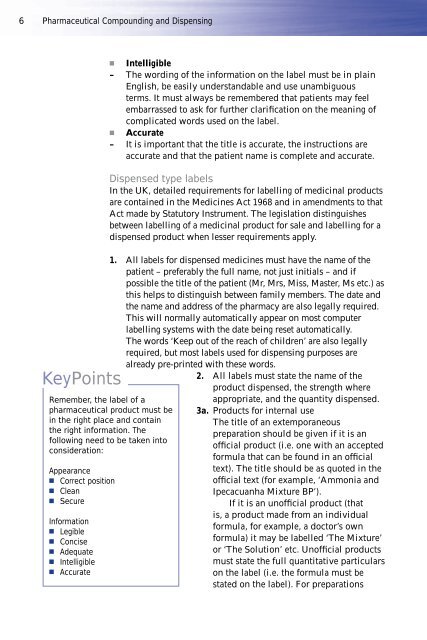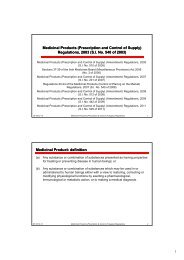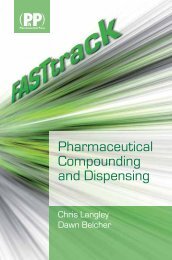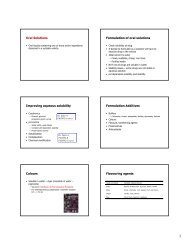Pharmaceutical Compounding and Dispensing - Pharmaceutics
Pharmaceutical Compounding and Dispensing - Pharmaceutics
Pharmaceutical Compounding and Dispensing - Pharmaceutics
Create successful ePaper yourself
Turn your PDF publications into a flip-book with our unique Google optimized e-Paper software.
6<br />
<strong>Pharmaceutical</strong> <strong>Compounding</strong> <strong>and</strong> <strong>Dispensing</strong><br />
KeyPoints<br />
Intelligible<br />
– The wording of the information on the label must be in plain<br />
English, be easily underst<strong>and</strong>able <strong>and</strong> use unambiguous<br />
terms. It must always be remembered that patients may feel<br />
embarrassed to ask for further clarifi cation on the meaning of<br />
complicated words used on the label.<br />
Accurate<br />
– It is important that the title is accurate, the instructions are<br />
accurate <strong>and</strong> that the patient name is complete <strong>and</strong> accurate.<br />
Dispensed type labels<br />
In the UK, detailed requirements for labelling of medicinal products<br />
are contained in the Medicines Act 1968 <strong>and</strong> in amendments to that<br />
Act made by Statutory Instrument. The legislation distinguishes<br />
between labelling of a medicinal product for sale <strong>and</strong> labelling for a<br />
dispensed product when lesser requirements apply.<br />
1. All labels for dispensed medicines must have the name of the<br />
patient – preferably the full name, not just initials – <strong>and</strong> if<br />
possible the title of the patient (Mr, Mrs, Miss, Master, Ms etc.) as<br />
this helps to distinguish between family members. The date <strong>and</strong><br />
the name <strong>and</strong> address of the pharmacy are also legally required.<br />
This will normally automatically appear on most computer<br />
labelling systems with the date being reset automatically.<br />
The words ‘Keep out of the reach of children’ are also legally<br />
required, but most labels used for dispensing purposes are<br />
already pre-printed with these words.<br />
Remember, the label of a<br />
pharmaceutical product must be<br />
in the right place <strong>and</strong> contain<br />
the right information. The<br />
following need to be taken into<br />
consideration:<br />
Appearance<br />
Correct position<br />
Clean<br />
Secure<br />
Information<br />
Legible<br />
Concise<br />
Adequate<br />
Intelligible<br />
Accurate<br />
2. All labels must state the name of the<br />
product dispensed, the strength where<br />
appropriate, <strong>and</strong> the quantity dispensed.<br />
3a. Products for internal use<br />
The title of an extemporaneous<br />
preparation should be given if it is an<br />
offi cial product (i.e. one with an accepted<br />
formula that can be found in an offi cial<br />
text). The title should be as quoted in the<br />
offi cial text (for example, ‘Ammonia <strong>and</strong><br />
Ipecacuanha Mixture BP’).<br />
If it is an unoffi cial product (that<br />
is, a product made from an individual<br />
formula, for example, a doctor’s own<br />
formula) it may be labelled ‘The Mixture’<br />
or ‘The Solution’ etc. Unoffi cial products<br />
must state the full quantitative particulars<br />
on the label (i.e. the formula must be<br />
stated on the label). For preparations





